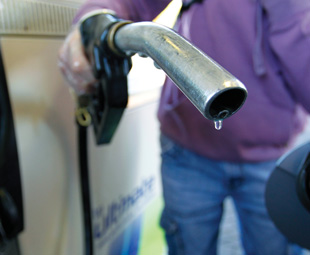Finding better fuel filtration

With fuel prices currently reaching record highs in South Africa, local consumers are at risk of facing further unforeseen costs when filling up their tanks as a result of contaminated fuel and oil that requires more effective methods of filtration, explains CRAIG FITZGERALD of Filter Focus
It is more important than ever to select a lubricant submicron particle filtration system which greatly assists in decreasing the levels of contamination found in fuels and new oils, while extending a vehicle’s fuel system component lifespan by 50 to 80 percent. The risk of contaminated fuel is a real threat in South Africa. This is clearly evident in a number of tests that have been carried out recently by Filter Focus (a wear control expert specialising in the development, design and manufacture of offline filtration systems) on behalf of high-profile clients, including Nedbank and Sasol.
FitzGerald explains: “After analysing the fuel quality in one of Nedbank’s bulk diesel tankers in January 2013, it was found that at below five micrometres (µm) there were 30 034 contaminants. At less than four µm, there were 34 400 contaminants per ml, which amounts to approximately 34 million contaminants per litre. After undergoing several hours of micro-fine filtration, the levels of contamination fell to about 50 contaminants at less than five µm, and about 100 contaminants below four µm.”
An oil filtration trial undertaken for Sasol on new 15W40 engine oil also found that the unfiltered drum at four µm contained 17 364 contaminants. After one full pass through the filter system, this level fell to 11 895 contaminants. After 24 hours of filtration the number of contaminants fell to just 294.
At present South African refineries are attempting to remove only sulphur, benzene and aromatics from fuel to reduce emission levels once the fuel is combusted. Sulphur occurs naturally in crude oils and must be reduced to an acceptable level during the refining process, as it promotes corrosion and affects the performance of emissions- control equipment in vehicles. Although sulphur does not affect engine performance directly, it does reduce the efficiency of catalytic converters.
There is no performance or emissions effect on older vehicles not fitted with catalytic converters. All vehicles with operating catalytic converters will, however, show some reduction in fuel sulphur emissions. The magnitude of the effect will vary according to the technology employed, the vehicle, the condition of the converter and the driving mode.
Current South African and international specifications
The Sasol synthetic fuel process produces fuel products with low sulphur content, typically below the “ultra-low sulphur” threshold of 10 parts per million (ppm). The conventional crude oil refineries in South Africa are more constrained in their ability to produce low sulphur fuels.
 South African fuel specifications currently allow two distinct fuel grades – metal-free unleaded petrol (ULP) which may not contain metal additives, and unleaded petrol containing metal, commonly referred to as lead replacement petrol (LRP).
South African fuel specifications currently allow two distinct fuel grades – metal-free unleaded petrol (ULP) which may not contain metal additives, and unleaded petrol containing metal, commonly referred to as lead replacement petrol (LRP).
These two fuel grades have different sulphur specifications. The LRP grade is not intended for use in vehicles with catalytic converters and is typically dispensed through a large diameter nozzle which will not fit vehicles manufactured after 2001. There is, therefore, no significant benefit to reducing the sulphur content of this grade of fuel.
When refineries remove sulphur from diesel, they must be careful not to affect its lubricity. The lower the levels of lubricity, the less ability the fuel has to provide lubrication of wetted components. Oil refineries are attempting to counter this by adding lubricity enhancers, as it is the diesel which lubricates the fuel system components and pumps in these vehicles.
When solids contaminate the fuel, the issue of lubricity becomes a more critical factor. The local and international drive to reduce the levels of sulphur in fuel, combined with efforts to reduce vehicle emissions, is having a detrimental effect on the performance of automotive equipment. Modern fuel systems operate at higher pressures than older versions from the past 30 years, in order to atomise diesel more efficiently.
Diesel is a controlled burn, and therefore, burns from the outside in. If a system’s diesel droplets increase in size, the burn period increases accordingly. When diesel is finally atomised, it burns up quickly and less unburnt fuel will exit through a vehicle’s exhaust pipe. While original equipment manufacturers have recently been increasing injector and fuel operating pressures, and refineries have been removing sulphur from their diesels, FitzGerald says what is not being addressed is the contamination in the fuel itself, in the form of rust, sand, dust, water moisture or other forms of contamination. “Lower levels of lubricity and higher operating pressures have a sand blasting-type effect on fuel system components and on diesel injectors,” he states.
Using contaminated diesel fuels in high-pressure engines is a further cause of rapid engine oil deterioration. The effect of the contamination, over time, will result in fuel injectors eroding and, as this occurs, the diesel droplets which have been atomised, start increasing in size.
When an exhaust valve opens in a combustion chamber, fuel will still be burning as a result of its increased size. However, when an exhaust valve opens and sucks the burning fuel into a vehicle’s fire box and extinguishes that fire, unburnt hydrocarbons will enter and eventually exit out of the exhaust pipe. Therefore, the vehicle’s carbon dioxide emissions increase instead of decreasing.
 With the current trend towards tighter specifications for both petrol and diesel, it is important that every refinery has a long-term strategy for meeting these new goals. Many of the technologies for upgrading both petrol and diesel to meet ultra-low sulphur levels will be a licensed, rather than an open art.
With the current trend towards tighter specifications for both petrol and diesel, it is important that every refinery has a long-term strategy for meeting these new goals. Many of the technologies for upgrading both petrol and diesel to meet ultra-low sulphur levels will be a licensed, rather than an open art.
In addition, the offsite facilities will need to be upgraded to enable the handling of these higher-specification products and, the integration within the refinery will need to be reviewed, as the solutions will not be simple. Refineries will focus specifically on strategy development for meeting clean fuel legislation, while maximising the effectiveness of capital.
A refinery’s cleaner fuels programme needs to be holistic and not focus solely on reducing sulphur levels in fuel. Based on research undertaken on new, unused diesel, Filter Focus has found that at the four µm level, there are between 15 000 and 50 000 contaminants for every millilitre of diesel, which equates to between 15 million and 50 million contaminants for every litre of diesel. This is currently regarded by the fuel industry as acceptable.
FitzGerald concludes: “I strongly believe that this is not an acceptable level of contamination for a fuel or lubricating system, as contamination in any size or form is detrimental and will cause significant harm to vehicles and industrial equipment. Standard spin-on filtration is currently not up to the task to protect modern equipment.”
Published by
Focus on Transport
focusmagsa




